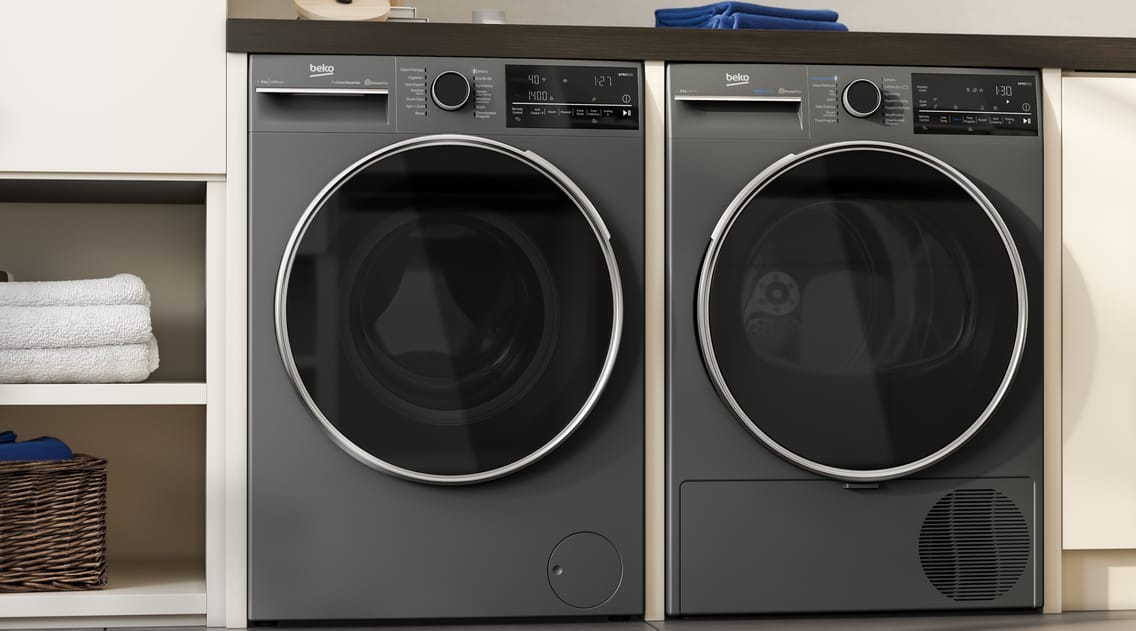Washer Dryer vs Washing Machine and Tumble Dryer: What’s the Best Choice for Your Home?
The decision between purchasing a washer dryer or standalone washing machine and tumble dryer is one that should not be taken lightly.
There are of course positives and negatives to both options, and the aim is to discuss both sides and aid you in your decision when purchasing your next washing machine appliance.

Understanding Washer Dryers
The washer dryer is an appliance which has simplified the process of laundry by combining the role of the washing machine and tumble dryer into one appliance.
It is not just the simplified process that has won the washer dryer its share of fans, but the space saving element too. Without the need for a separate washing machine and tumble dryer, consumers are reclaiming space in their homes.
The key difference when it comes to using the drying element in a washer dryer is that there’s no water tank. Instead, the water from your laundry is pumped and extracted out of the system via a drainage pipe.
Beko has several washer dryers on offer online with the key differences being washing capacity, drying capacity, size of the appliance and energy efficiency ratings.
Comparing Costs: Washer Dryer vs Separate Washing Machine and Tumble Dryer
The washer dryer will generally be cheaper to buy than purchasing two appliances separately.
Efficiency Breakdown: Energy and Water Use
Before purchasing a washer dryer there are several factors to consider, with one of the most important being the energy efficiency and water usage.
Generally, washer dryers are less energy efficient than a separate washing machine and tumble dryer alternative. This is down to several factors, but the combination of functions in a single appliance ultimately leads to higher energy usage.
To figure out the precise cost of a washer dryer compared to standalone appliances, you will need to check the kWh usage of your washer dryer and multiply this by your tariff costs, along with how often you use your appliance. The kWh usage of your appliance can be found on our website. To find this information, simply insert your model number into the search bar on our site and click through to your product’s page. Once on this page, scroll down to the product specification section where the consumption value can be found.
Not only that, but water usage is usually higher with a washer dryer, too, due to the drum size tending to be smaller.
As a result, the combined operation of the single appliance will typically have higher running costs than using a separate washing machine and tumble dryer.
Performance Comparison: Washing and Drying
When evaluating the washer dryer vs. standalone washing machine and tumble dryer, there are some differences in performance that are worth considering before making a purchase, particularly in terms of the cleaning effectiveness of a washing cycle, the drying speed and ultimately the efficiency overall.
The washer dryer delivers excellent performance, but as a combined appliance for washing and drying, it comes with some compromises in certain cleaning technologies, such as the spin speed it can achieve. While the lower spin speed may impact drying efficiency, the laundry will still be cleaned to the performance standards declared in the UK Ecodesign and Energy Labelling Regulations.
For consumers looking for an appliance that can handle large loads and faster drying times, the separate washing machine and tumble dryer are ultimately the best options. But despite this, the space-saving and all-in-one functionality of a washer dryer will still tempt many consumers due to the convenience this option offers.
Space Considerations and Practicality
We have a host of different washer dryer, washing machine, and tumble dryer options on offer. The variety means that we offer a laundry appliance that fits all individual's lifestyle and living space.
The washer dryers and their compact size are a great option for those who live in a flat or apartment, or simply do not have a designated laundry room, and removes the need for two separate machines.
Although generally larger in size, and separate standalone machines, the washing machine and tumble dryer are a better choice for consumers with space, and offers the opportunity to have a wash and tumble dry for different loads running simultaneously.
Which Option Is Best for Your Home?
The setup which will best suit your needs is simple: If space is not an issue, and you don’t mind spending a little more, then a separate washing machine and tumble dryer is likely best for you. It will save you money on utility bills in the long run, reduce your carbon footprint, and leave your clothes cleaner, fresher and dryer.
But, of course, not everyone has the space for the two machines, and the washer dryer options at Beko are worth investigating for consumers seeking a two in one appliance.
Additional Considerations
In terms of maintenance and lifespan, if there is an issue with your washing machine or tumble dryer, you will still be able to utilise one of the appliances (assuming both don’t have an issue at the same time), whereas if the washer dryer has an issue which requires a fix, you won’t be able to wash or dry.
With longevity in mind, you are most likely to find that a standalone washing machine and tumble dryer will outlive a washer dryer, with a primary reason being that the separate appliances tend to have fewer components that can wear out.
Frequently Asked Questions Washer Dryers vs Separate Washing Machines and Tumble Dryers
What are the main differences in running costs?
Over time a consumer will find that running costs will typically be lower in the standalone washing machine and tumble dryer vs. a washer dryer due to lower energy consumption, water usage and maintenance costs.
Which option is more energy efficient?
The standalone washing machine with a heat pump tumble dryer is the more energy efficient when compared with a washer dryer.
How do performance levels compare between the two setups?
Although the washer dryer performs well, the standalone washing machine and tumble dryer is superior for cleanliness of the laundry, and the dryness following a cycle, too.
What should I consider when choosing between a washer dryer and separate machines?
You should consider your individual needs and requirements first and foremost. Secondly, space, as many properties are not suitable for separate machines, and then also the energy and water usage, which will ultimately affect utility bills.



